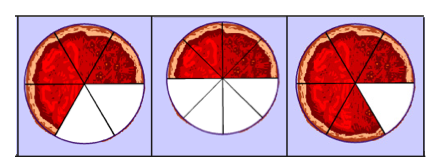Discussion/Introduction
What does it mean when a fraction is the same as another, and what does it mean when it is different? Is 2/4 really the same as ½? Although your students have discovered informally that the slab of pie represented by those two fractions— and the point on the number line—looks, feels, and acts the same, they still need to take this one step further and realize that these two fractions are actually one and the same quantity.
This 3rd grade lesson plan will give students the tools they need to understand the concepts of same and different applied to fractions. Through visual ordering exercises your students will become adept at recognizing fractions that are the same, and by the end of today’s session they should be able to make up their own simple lists of equivalent fractions.
Fractions and Ordering: Discovering Equivalence
It’s important that you introduce this topic with real world, dynamic, easily understandable examples rather than with mathematical equations and manipulations. Your students aren’t ready, right now, to grasp that 2/4 is ½ because they can divide 2 out of both sides of that first fraction. That is for later. Introduced with fancy manipulation, fractions become a complicated numerical puzzle that will leave many of your students feeling confused and helpless. When demonstrated with visual examples, though, equivalent fractions will speedily seem intuitive to your students; nothing less than common sense.
Objective
Students will understand that two fractions are equivalent if they are the same size, or the same point on a number line. They will be able to explain why fractions are equivalent, and will be able to recognize and make up lists of simple equivalent fractions.
Supplies
- Folding paper, 1 square per student.
- Flashcard sets; one per student (download printables)
- 2 scrabble tile holders
Methodology/Procedure
As a warmup, begin with a quick fractions review. Pass out the folding paper, and have your students fold fractions—as fast as possible; first one done is the winner—as you call them out. Call out ½, 1/3, ¼, 1/6, and 1/8, in random order.
If they have difficulty, continue this exercise for several rounds. When they achieve fluency, tell them you are proud. Tell them you’ve got a fun topic to look at today; and it’s a topic you won’t even need to teach; they can discover it all themselves. Give each student a partial set of fraction number & visual flashcards; ½, ¼, 2/4, and ¾ cards from both visual and numerical sets. Ask them to match the cards to the pie pictures, and then to order both sets according to size, smallest to largest.
When they have finished, walk around the room and review the students’ work. Help any who have had trouble, encouraging them to look at the picture cards and compare relative sizes. Find two students who have chosen different orderings, and give them the scrabble tile holders. Ask them to place their numerical cards carefully on the tile holder, then go to the front of the room and display their ordering to the class. Observe that these are two different orderings of the same set; ask which is wrong.
Invite any students who point out one or the other as wrong to explain why it is wrong, using the picture flashcards and comparing sizes.
If your students say unanimously that neither is wrong, tell them that they are right. Draw on the board the visual circle fractions, and demonstrate how the two parts are exactly the same.
Tell them that in math the two fractions ½ and 2/4 are called equivalent fractions. Explain that what that means is that they are two names for the same thing. Sometimes one name is more useful, sometimes the other is. Ask them if they know anyone who has two names. If they do not come up with their own examples, remind them of a common acquaintance—the principal, perhaps, who is called Mr. Brown at school, Daddy at home, and Jake by his golfing friends. Point out that the man these names this refers to is the same, no matter what name he is called, and that all of these names belong to him equally.
You can also use yourself as an example.
Draw a half circle on the chalkboard, and tell your students this could be labeled as ½ or 2/4, and both answers would be entirely correct. Ask them if they can think of any other names for this same portion.
If any students have suggestions, invite them to come up and demonstrate equivalence on the board with pictures. If no-one has any idea, use lines to divide the circle on the board into eight equal wedges, and point out that half is also four 1/8 wedges, or 4/8.
Ask your students how many names each portion has. Let them think about and discuss this, and then demonstrate how each portion will have an infinite number of names, because you can always divide the existing pieces each in half again to get twice the amount of smaller pieces.
Hand out the remaining card sets, and ask the students to match the number cards to the visual cards and then order all the cards by portion size, from smallest to largest. Suggest they show equivalence by placing equivalent fractions at the same level in their orderings.
Let your students take their times over their orderings. If they finish quickly and you have time left before the end of the class, do some quiz work: draw shaded portions on the blackboard and ask your students to help you come up with a list of possible ‘names’.
Common Core Standards
This lesson is aligned to standard 3.NF.3 in the Common Core State Standards for Mathematics; 3rd Grade Numbers and Fractions item 3. 3.NF.3 reads, in part:
3.NF. 3. Explain equivalence of fractions in special cases, and compare fractions by reasoning about their size.
a. Understand two fractions as equivalent (equal) if they are the same size, or the same point on a number line.
b. Recognize and generate simple equivalent fractions, e.g., 1/2 = 2/4, 4/6 = 2/3. Explain why the fractions are equivalent, e.g., by using a visual fraction model.
Web Resources/Further Exploration
The beautiful flashcards your students used in this lesson are made with the help of Mathwarehouse’s nifty Visual Fraction applet. This applet is a really fun way to generate classroom graphics, and also an enjoyable way for students who might be having difficulty visualizing fractions to see pizza portions generated before their eyes as they type in the fractions they are curious about.


